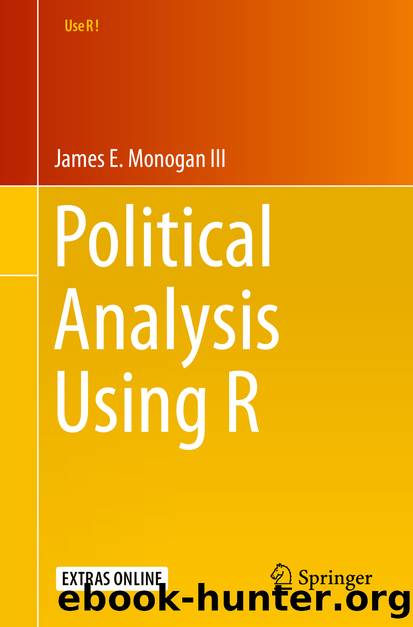Political Analysis Using R by James E. Monogan

Author:James E. Monogan
Language: eng
Format: epub
Publisher: Springer International Publishing, Cham
After the first seven chapters of this volume, users should now be able to perform most of the basic tasks that statistical software is designed to do: manage data, compute simple statistics, and estimate common models. In the remaining four chapters of this book, we now turn to the unique features of R that allow the user greater flexibility to apply advanced methods with packages developed by other users and tools for programming in R.
7.4 Practice Problems
1.Logistic regression: Load the foreign library, and download a subset of Singhâs (2015) cross-national survey data on voter turnout, the file stdSingh.dta, available from the Dataverse listed on page vii or the chapter content listed on page 97. The outcome variable is whether the survey respondent voted (voted). A key predictor, with which several variables are interacted, is the degree to which a citizen is subject to mandatory voting rules. This is measured with a scale of how severe the compulsory voting rules are (severity). Five predictors should be interacted with severity: age (age), political knowledge (polinfrel), income (income), efficacy (efficacy), and partisanship (partyID). Five more predictors should be included only for additive effects: district magnitude (dist_magnitude), number of parties (enep), victory margin (vicmarg_dist), parliamentary system (parliamentary), and per capita GDP (development). All of the predictor variables have been standardized. a.Estimate a logistic regression model with these data, including the five interaction terms.
Download
This site does not store any files on its server. We only index and link to content provided by other sites. Please contact the content providers to delete copyright contents if any and email us, we'll remove relevant links or contents immediately.
International Integration of the Brazilian Economy by Elias C. Grivoyannis(57319)
The Radium Girls by Kate Moore(10907)
Turbulence by E. J. Noyes(7037)
Nudge - Improving Decisions about Health, Wealth, and Happiness by Thaler Sunstein(6633)
The Black Swan by Nassim Nicholas Taleb(6190)
Pioneering Portfolio Management by David F. Swensen(5605)
Rich Dad Poor Dad by Robert T. Kiyosaki(5147)
Zero to One by Peter Thiel(4823)
Man-made Catastrophes and Risk Information Concealment by Dmitry Chernov & Didier Sornette(4735)
Secrecy World by Jake Bernstein(3782)
Millionaire: The Philanderer, Gambler, and Duelist Who Invented Modern Finance by Janet Gleeson(3568)
Skin in the Game by Nassim Nicholas Taleb(3459)
The Age of Surveillance Capitalism by Shoshana Zuboff(3421)
The Money Culture by Michael Lewis(3284)
Skin in the Game: Hidden Asymmetries in Daily Life by Nassim Nicholas Taleb(3264)
Bullshit Jobs by David Graeber(3179)
The Dhandho Investor by Mohnish Pabrai(3167)
The Wisdom of Finance by Mihir Desai(3077)
Blockchain Basics by Daniel Drescher(2890)
